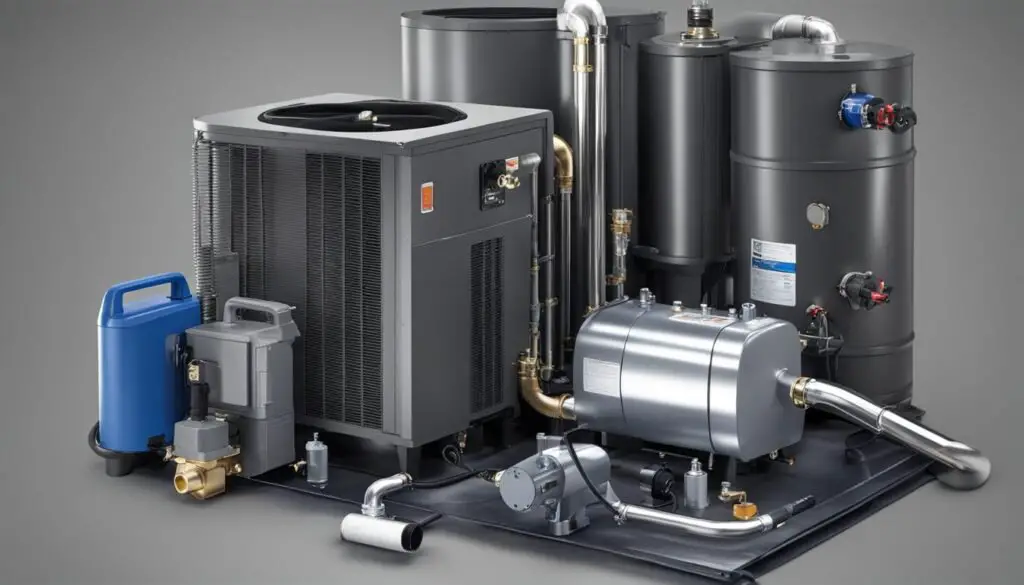Welcome to the step-by-step guide on how to install a central vacuum cleaner in your home. Whether you’re looking to save time and effort on cleaning or want to improve indoor air quality, installing a central vacuum system can be a game-changer. In this guide, I will walk you through the process, sharing expert tips and instructions to help you successfully install your own central vacuum system.
Key Takeaways:
- Detailed instructions and expert tips for installing a central vacuum system
- The advantages of installing a central vacuum system, including improved indoor air quality and longer vacuum lifespan
- An overview of the key components of a central vacuum system
- The necessary tools and supplies needed for installation
- Step-by-step instructions for planning the layout, installing the power unit and PVC tubing, running low voltage wiring, and checking the system
Advantages of Installing a Central Vacuum System
Installing a central vacuum system offers numerous advantages that contribute to a cleaner and healthier home environment. Let’s explore the key benefits:
- Improved Indoor Air Quality: Unlike traditional standalone vacuum cleaners that recirculate air back into the living spaces, central vacuum systems improve indoor air quality by venting the exhaust outside. This reduces the presence of allergens, dust, and particles in the air, creating a healthier environment for you and your family.
- Centralized Vacuuming: With a central vacuum system, you can effortlessly clean every area of your home without the hassle of dragging a heavy vacuum cleaner from room to room. The strategically placed inlet valves allow you to conveniently connect the hose and accessories, enabling you to quickly and efficiently vacuum all surfaces.
- Reduced Noise and Allergens: The power unit or canister/filter system of a central vacuum is typically located in a remote area like a garage or utility room. This placement reduces noise levels in the living spaces, ensuring a more peaceful and comfortable environment. Additionally, by removing the exhaust outside the living areas, central vacuum systems minimize the concentration of allergens and dust, further improving the overall air quality.
- Efficient Filtration: Central vacuum systems often utilize bags for collecting dirt and debris. These bags offer superior filtration compared to bagless models, trapping microscopic particles and allergens more effectively. The use of bags not only improves indoor air quality but also enhances the longevity and performance of the system by preventing clogs and maintaining optimal airflow.
- Longer Vacuum Lifespan: Central vacuum systems are built to last. In contrast to traditional vacuum cleaners that require frequent maintenance and may have a limited lifespan, central vacuum motors are designed to endure heavy use and provide years of reliable service. With proper care and maintenance, the lifespan of a central vacuum system can significantly surpass that of a traditional vacuum cleaner.
By installing a central vacuum system, you can enjoy these advantages while achieving a cleaner and healthier home. Your indoor air quality will improve, the cleaning process will be more efficient, and your vacuum’s lifespan will be extended.
Components of a Central Vacuum System
A central vacuum system consists of several key components that work together to provide effective and convenient cleaning. Understanding these components is essential for a successful central vacuum installation. Let’s take a closer look at each one:
1. Power Unit
The power unit, also known as the canister or filter system, is the heart of the central vacuum system. It houses the vacuum motor and filters, ensuring powerful suction and efficient filtration. When choosing a power unit, consider factors such as motor power, filter type, and capacity to meet your cleaning needs.
2. PVC Piping
PVC piping forms the backbone of the central vacuum system. It creates the airflow necessary to transport dirt and debris from the inlets to the power unit. High-quality, properly sized PVC piping ensures optimal performance and efficient cleaning throughout your home.
3. Inlets
Inlets, or inlet wall plates, are strategically installed in your home to provide connection points for power brushes and hoses. They are usually placed in convenient locations such as walls or baseboards, allowing easy access to the vacuum system. When choosing inlets, consider the number and placement to ensure comprehensive coverage.
4. Power Brushes
Power brushes are essential attachments for effective cleaning in a central vacuum system. These motorized brushes are designed to clean various surfaces, such as carpets, rugs, and upholstery, with ease. Choose power brushes with adjustable height settings and different brush types to tackle different cleaning tasks.
5. Hoses
Hoses connect to the inlets and power brushes, allowing you to access the cleaning power of the central vacuum system. Opt for high-quality hoses that are durable, flexible, and have appropriate lengths to reach all areas of your home. Consider features like on/off switches and adjustable suction control for added convenience.
6. Accessories
In addition to power brushes and hoses, a wide range of accessories further enhances the versatility of a central vacuum system. These accessories may include crevice tools, dusting brushes, upholstery tools, and more. Choose accessories that suit your cleaning needs and allow you to tackle different surfaces and hard-to-reach areas effectively.
By understanding the components of a central vacuum system, you can make informed decisions when selecting and installing the system in your home. Remember to choose high-quality components that are compatible with your system to ensure optimal performance and long-term satisfaction.

Steps to Install a Central Vacuum System
Installing a central vacuum system in your home is a great way to make cleaning easier and more efficient. By following these simple steps, you can have a system that will keep your home clean and dust-free.
Before you begin, gather the general tools and supplies needed for the installation. This includes a tape measure, drill, screwdriver, PVC primer and glue, wire strippers, and other basic tools. Having these items on hand will make the installation process smoother and more convenient.
The first step in installing a central vacuum system is to plan the layout. Take time to determine the placement of inlets and the routing of PVC tubing throughout your home. This will ensure optimal performance and efficiency.
Next, install the central power unit in a heated area such as a garage or utility room. This will provide easy access and help maintain the lifespan of the system. Once the power unit is in place, you can proceed to install the PVC tubing and inlet valves to create the vacuuming network.
Running the low voltage wiring alongside the PVC tubing is the next step. This wiring is necessary for the system to function properly, so make sure to follow the manufacturer’s instructions carefully. Finally, it is important to thoroughly check the system to ensure everything is connected and functioning as it should be.
By following these steps and using the right tools and supplies, you can successfully install a central vacuum system in your home. Enjoy the convenience and efficiency of a clean home with this easy-to-use system.
FAQ
What are the advantages of installing a central vacuum system?
Installing a central vacuum system improves indoor air quality, reduces noise and allergens in living spaces, provides better cleaning performance, and offers more efficient filtration and a longer lifespan for the system.
What are the components of a central vacuum system?
The components of a central vacuum system include the power unit or canister/filter system, PVC piping, inlets or inlet wall plates, power brushes, hoses, and accessories.
What are the general steps to install a central vacuum system?
The general steps to install a central vacuum system involve planning the layout, installing the central power unit, installing PVC tubing and inlet valves, running low voltage wiring, and thoroughly checking the system for proper functionality.





Leave a Reply